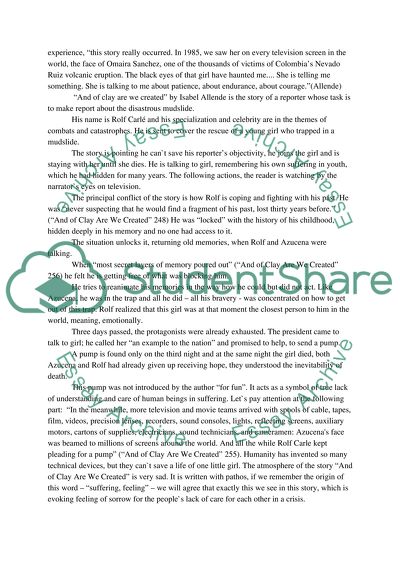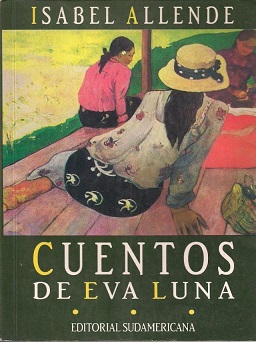Theme
- And Of Clay Are We Created By Isabel Allende Summary
- And Of Clay Are We Created By Isabel Allende Pdf
- And Of Clay Are We Created By Isabel Allende Short Story
- And Of Clay Are We Created By Isabel Allende Narration Scripts
In “Death Constant Beyond Love” by Gabriel García Marquez there is a theme of death, while in the stories “And of Clay Are We Created” by Isabel Allende and “The Garden of Forking Paths” by Jorge Luis Borges there is a common theme of choice.
This Study Guide consists of approximately 39 pages of chapter summaries, quotes, character analysis, themes, and more - everything you need to sharpen your knowledge of And of Clay Are We Created. Allende, Isabel, 'Writing As an Act of Hope,' in.
Gabriel Garcia-Marquez’s story “Death Constant Beyond Love” is the first story I will be analyzing the theme in. The main character in the story is Senator Onésimo Sánchez who “had six months and eleven days to go before his death when he found the woman of his life” (1653). It is ironic for someone to meet the love of their life before they are about to die. He was told he would be dead by the next Christmas. The Senator does not tell anyone about his death and keeps it a secret, the only people who know are his doctors.
- Although the volcanic eruption on which 'And of Clay Are We Created' is based occurred in Colombia in 1985, Allende does not specify the date and location in which the story is set. Like the rest of the collection The Stories of Eva Luna, the story is understood to take place somewhere in Latin America, sometime during the 1980s.
- And of Clay Are We Created ISABEL ALLENDE By appealing to all five senses, writers enlarge our sense of involvement as the action unfolds. When reading a story, observe how the author presents details of sound, sight, smell, taste and touch. ACTIVITY B Directions The phrases below were used in “And of Clay Are We Created” to heighten the.
Isabel Allende’s short story, “And of Clay Are We Created” has the theme of choice. The story takes place from the aftermath of the eruption of Nevado del Ruiz, which was a volcano eruption in Colombia. Rolfe Carlé, one of the main characters in the story, is a reporter who is covering the mudpit, while he is covering the mudpit he sees a girl, Azucena, trapped in the mud. Carlé’s reporting job kept him busy from remembering his past, which is his time spent in Europe at the concentration camps. Isabel Allende used Azucena to help Rolfe Carlé remember that he will not be able to face his past/fears until he accepts them. Choice can be seen in this line “But he had come face to face with the moment of truth; he could not continue to escape his past. He was Azucena; he was buried in the clayey mud; his terror was not the distant emotion of an almost forgotten childhood, it was a claw sunk in his throat” (1241). Carle finally made the decision to be face to face with reality, and he knew he could no longer escape his past.
Choice in“The Garden of Forking Paths” by Jorge Luis Borges can be seen throughout the story, but I want to point out choice towards the end of the story. In Borges’ short story, he uses alternate universes, “to read one of Borges’s stories is to enter a new reality, imagined with great concreteness as an extension of our own world yet bearing distinctive features of the universes of fantasy and science fiction (1336). He “portrays the universe as a series of alternative versions of experience” (1337) because the story starts as a regular spy story, but then changes. “The Garden of Forking Paths’ was the chaotic novel; the phrase ‘the various futures (not to all)’ suggested to me the forking in time, not in space,” (1342). Yu T’sun finds out“The Garden of Forking Paths” is actually a book about Fang who has a choice to kill an intruder or not to kill him. This made me think of Yu T’sun who had the gun and had the choice to kill or not to kill Madden.
Literary Devices
Jorge Luis Borges uses magical realism in “The Garden of Forking Paths.” Yu Tsun, the main character in the story, is a German spy during World War I. With Yu Tsun being a German spy during this time period, this shows the realism in the story. Yu Tsun seems as though he is weaving his way through a path. Yu Tsun asked for help to navigate his way to Stephen Albert’s house, and the men tell him to turn left at every crossroad.Yu Tsun thought, “The road descended and forked among the now confused meadows,” (1340). The labyrinth represents magical realism. Borges incorporated information about Yu Tsun’s ancestor, Ts’ui Pen, and his labyrinth into the story. Labyrinth’s usually always guides a person to take left turns, which is what Yu Tsun does in the story. It is almost as though Yu Tsun is bringing a story to life because he is literally walking the labyrinth, which is the magical realism in the story. Future writers should re-read “Death Constant Beyond Love” and look for the magical realism in that story.
“Death Constant Beyond Love” uses symbolism in the story. The “rose” symbolizes love or even romance, “Even its name was a kind of joke, because the only rose in that village was being worn by Senator Onésimo Sánchez himself on the same afternoon when he met Laura Farina,” (1653). One can assume that the Senator was looking for love. He obviously believed in love because he was wearing a rose. If you haven’t read the story, you will see the romance between the Senator and Ms. Farina. Symbolism is great in a story. I think of it like a “word search” because symbolism does not always stand out at first, and in some stories or poems you have to find it. Including symbolism in your writing allows for an object or a thing to have a meaning to it. Symbolism adds meaning to a story. I suggest re-reading “Death Beyond Constant Love” and see if you can find any more symbols in the story.
The story “And of Clay Are We Created” uses imagery. One can see imagery in the first sentence of the story, “They discovered the girl’s head protruding from the mudpit, eyes wide open, calling soundlessly.” The use of imagery in this sentence is great because it makes it so easy for the reader to imagine this scene. I love how Isabel Allende chose to start her story this way. It engages and grabs the attention of the reader. I suggest those who are writers to do this. When you start your story with something interesting, your reader will be more interested in reading the story, and he/she will want to read more. This article actually gives 14 books one can read that use imagery. While reading the books, you can figure out exactly how you want to use imagery in your writings.
Works Cited
Allende, Isabel. “And of Clay Are We Created.” The Norton Anthology of World Literature, edited by Martin Puchner, et al., W.W. Norton, 2017, pp. 1735-1742.
Borges, Jorge Luis. “The Garden of Forking Paths.” The Norton Anthology of World Literature, edited by Martin Puchner, et al., W.W. Norton, 2017, pp. 1337-1344.
“Clay Center of St. Petersburg.” n.d. https://www.groupon.com/deals/clay-center-of-st-petersburg-1
Davis, Anthony M. “Magical Maze.” 2014. https://scribbledartsfromtheheart.com/2014/07/30/magical-maze/
“Deep Mud Pit.” 2015. http://www.heromud.com/deep-mud-pit/
“Fifty Flowers.” n.d. https://www.fiftyflowers.com/product/xxl-extra-extra-long-stemmed-freedom-red-rose.htm
Marquez, Gabriel-Garcia. “Death Constant Beyond Love.” The Norton Anthology of World Literature, edited by Martin Puchner et al., W.W. Norton, 2017, pp.1653-1658.

- Subterranean: underground.
- Avalanche: falling large mass, sudden rush of large quantity.
- Telluric: earthly.
- Putrefy: rot, decay.
- Presentiments: intuitive feeling or foreboding about the future.
- Tenacity: diligence, stubbornness.
- Fortitude: strength of mind, bravery.
- Pandemonium: commotion, anarchy, bedlam.
- Accentuated: focusing attention on.
- Frenzy: uncontrolled state or situation, agitation.
- Wrest: snatch.
- Torrent: heavy flow, cascade.
- Armoire: an ornate or antique cupboard/wardrobe.
- Geologists had set up their seismographs weeks before and knew that the mountain had awakened again. For some time they predicted that the heat of the eruption could detach the eternal ice from the slopes of the volcano, but no one heeded their warnings; they sounded like the tales of frightened old women.
- When I knew him better, I came to realize that his fictive distance seemed to protect him from his own emotions.
- He had completely forgotten the camera; he could not look at the girl through a lens any longer.
- He was Azucena; he was buried in the clayey mud; his terror was not the distant emotion of an almost forgotten childhood, it was a claw sunk in his throat.
- Rolf had wanted to console her, but it was Azucena who had given him consolation.


And Of Clay Are We Created By Isabel Allende Summary

And Of Clay Are We Created By Isabel Allende Pdf
- Human beings are fragile and impermanent.
- Memory and Reminiscence
And Of Clay Are We Created By Isabel Allende Short Story
- Who is the central character of this story: Rolf Carle, Azucena or the narrator? How is Rolf Carle changed by his involvement with Azucena?
- What does the story suggest about the relationship between human tragedy or catastrophe and media reportage? Does the presence of the journalist Rolf Carle alter the situation in which Azucena is trapped? If so, how?
- Why does Azucena die, despite the sustained human efforts and technological assistance enlisted on her behalf? What does the story suggest about the relationships between a developing country's response to a natural disaster, the international media's response to it, and the human costs?
- What is the irony associated with Rolf Carle and Azucena? Explain the religious elements in the story.
- Why do you think the local population gave no heed to the warnings of the geologists before the eruption?